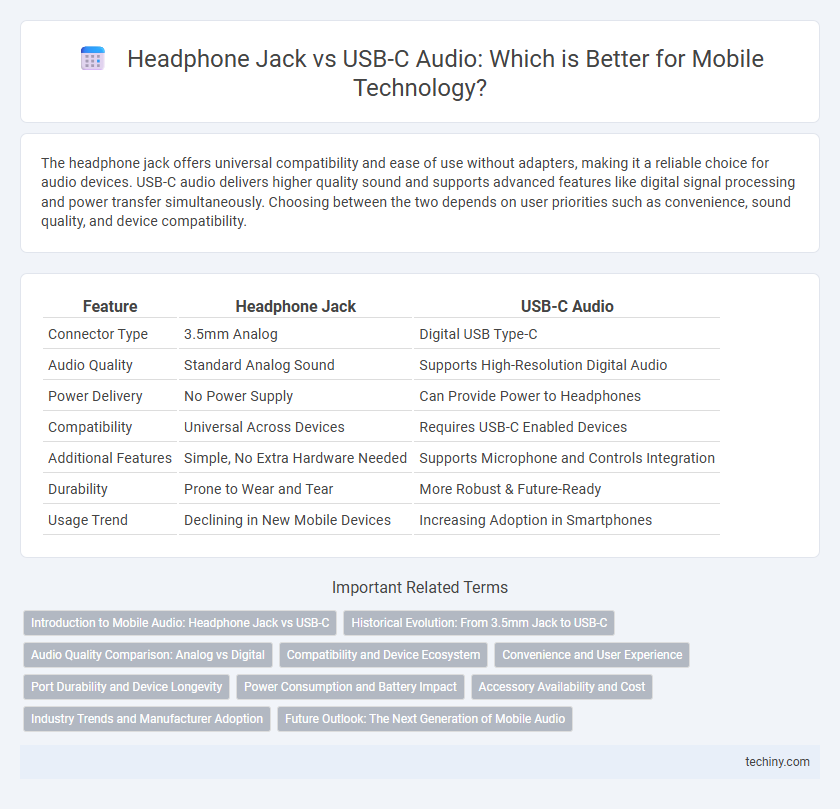The headphone jack offers universal compatibility and ease of use without adapters, making it a reliable choice for audio devices. USB-C audio delivers higher quality sound and supports advanced features like digital signal processing and power transfer simultaneously. Choosing between the two depends on user priorities such as convenience, sound quality, and device compatibility.
Table of Comparison
| Feature | Headphone Jack | USB-C Audio |
|---|---|---|
| Connector Type | 3.5mm Analog | Digital USB Type-C |
| Audio Quality | Standard Analog Sound | Supports High-Resolution Digital Audio |
| Power Delivery | No Power Supply | Can Provide Power to Headphones |
| Compatibility | Universal Across Devices | Requires USB-C Enabled Devices |
| Additional Features | Simple, No Extra Hardware Needed | Supports Microphone and Controls Integration |
| Durability | Prone to Wear and Tear | More Robust & Future-Ready |
| Usage Trend | Declining in New Mobile Devices | Increasing Adoption in Smartphones |
Introduction to Mobile Audio: Headphone Jack vs USB-C
The transition from traditional 3.5mm headphone jacks to USB-C audio interfaces marks a significant evolution in mobile technology, enhancing audio quality and charging capabilities simultaneously. USB-C supports digital audio output, enabling higher fidelity and noise reduction compared to the analog signals transmitted via headphone jacks. Mobile devices increasingly adopt USB-C audio to unify connectors, streamline design, and improve user experience with advanced audio codecs and power efficiency.
Historical Evolution: From 3.5mm Jack to USB-C
The transition from the 3.5mm headphone jack, introduced in the late 19th century, to USB-C audio reflects a significant evolution in mobile technology connectivity standards. The 3.5mm jack, once ubiquitous for analog audio transmission, is increasingly replaced by USB-C ports that support digital audio, multi-functionality, and improved sound quality in modern smartphones. This shift is driven by industry trends toward slimmer device designs, enhanced audio features, and the consolidation of charging and audio output interfaces.
Audio Quality Comparison: Analog vs Digital
The headphone jack delivers analog audio signals, preserving continuous sound waves that result in rich and natural audio quality with minimal latency. USB-C audio, utilizing digital signals, allows for advanced processing, noise cancellation, and higher dynamic range, but its quality depends heavily on the digital-to-analog converter (DAC) integrated in the device or adapter. Audiophiles often prefer analog jack connections for pure sound fidelity, while USB-C offers versatility and enhanced features through digital encoding.
Compatibility and Device Ecosystem
Headphone jacks offer universal compatibility across a wide range of devices, including older smartphones, laptops, and audio equipment, making them ideal for users with diverse device ecosystems. USB-C audio provides a streamlined connection with enhanced digital audio quality but often requires adapters or specific USB-C compatible peripherals, potentially limiting seamless integration. Device ecosystems favor USB-C for its multifunctionality, yet headphone jacks maintain an edge in broad compatibility without the need for additional adapters.
Convenience and User Experience
The headphone jack offers universal compatibility and instant plug-and-play convenience, allowing users to connect traditional headphones without adapters or power concerns. USB-C audio delivers enhanced sound quality and supports digital features like noise cancellation, but requires compatible devices and may necessitate adapters, affecting ease of use. Overall, the headphone jack prioritizes straightforward user experience, while USB-C audio balances convenience with advanced audio capabilities.
Port Durability and Device Longevity
USB-C ports offer enhanced durability compared to traditional headphone jacks due to their reinforced connectors designed for repeated insertions and removals. Devices equipped with USB-C audio benefit from reduced wear and tear, extending overall device longevity by minimizing port damage. In contrast, 3.5mm headphone jacks, with their smaller contact points, are more prone to loose connections and mechanical failure over time.
Power Consumption and Battery Impact
Headphone jacks consume minimal power as analog audio signals bypass digital conversion, resulting in lower battery drain compared to USB-C audio. USB-C audio requires digital-to-analog conversion, often increasing power consumption due to active DAC components and amplification processes. Consequently, devices with headphone jacks typically offer longer battery life during audio playback than those relying solely on USB-C audio output.
Accessory Availability and Cost
Headphone jacks offer widespread accessory availability due to their long-standing presence and compatibility with numerous devices and audio equipment, making them cost-effective for users seeking affordable options. USB-C audio, while increasingly popular in modern smartphones, presents a more limited range of accessories and typically involves higher costs for adapters and compatible headphones. The transition to USB-C audio impacts both accessory diversity and overall purchasing expenses for consumers in the mobile technology market.
Industry Trends and Manufacturer Adoption
The shift from traditional 3.5mm headphone jacks to USB-C audio ports reflects a significant industry trend driven by manufacturers aiming for slimmer device designs and enhanced audio capabilities. Major smartphone brands like Samsung, Google, and OnePlus have embraced USB-C audio to support digital sound transmission and advanced features such as active noise cancellation and higher-resolution audio formats. Despite some consumer resistance, the widespread adoption of USB-C audio aligns with regulatory standards and the push toward unified charging and audio interfaces across devices.
Future Outlook: The Next Generation of Mobile Audio
The transition from headphone jacks to USB-C audio ports signals a shift towards enhanced audio quality and integrated functionality in mobile devices. USB-C supports digital audio transmission, enabling features like active noise cancellation and high-resolution sound that traditional headphone jacks cannot deliver. Industry trends indicate widespread adoption of USB-C audio will accelerate, driven by consumer demand for improved audio experiences and device manufacturers embracing universal connectivity standards.
Headphone jack vs USB-C audio Infographic

 techiny.com
techiny.com